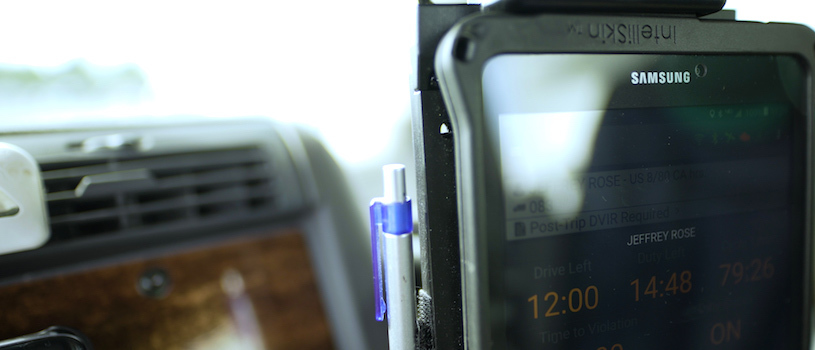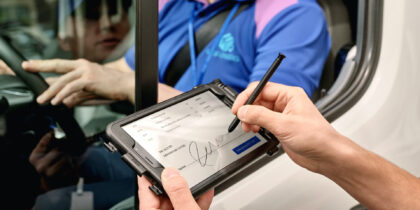The trucking industry is evolving. With the December 2017 electronic logging device (ELD) mandate deadline looming, cargo’s biggest names have rolled out new systems aimed at both compliance and efficiency. But when fleets range from a handful of vehicles to more than 20,000, it’s clear that solutions are not one-size-fits-all.
Fleets of 500 or fewer trucks have been latecomers to the e-log game. Why? First, a botched ELD implementation puts small carriers, where the workforce is accustomed to greater flexibility, at risk of alienating drivers and exacerbating the lack of experience in an industry that’s already seeing a shortage of nearly 48,000 truckers. Second, small carriers view the mandate as a greater imposition, as its potential downsides could hit small fleets disproportionately hard.
With time running short and the trucking industry in flux, it’s important to view changes not as irritations, but as occasions to stand out. Thankfully, we already know that ELD solutions for fleets large and small can be tailored to take advantage of new opportunities and help streamline small fleet management.
The Future of Fleet Management
Get the facts on the ELD mandate and what it means for trucking fleets. Download Now
The most basic, integrally synchronized fix allows drivers to log hours of service (HOS) quickly and easily – recouping some of the industry’s estimated $1.7 billion spent annually on paperwork. But to capitalize on changing technology, some small fleet COOs, IT managers and drivers are finding more comprehensive solutions to be a better alternative.
Looking past compliance, here are seven ways that smart device implementations are paying off for smaller fleets:
1. Intelligent Navigation – Navigation is a necessity for any driver, and minimal installation makes the upgrade that much easier. A turnkey, dashboard-mounted tablet solution can provide more detailed and easy-to-use data than traditional navigation options. Such systems feature millions of points of interest, ETA, speed, elevation, customizable vehicle profiles, large junction views and “next two turns” displays. As big carriers implement the latest right-turn-biased, time- and fuel-saving technology, it’s crucial that small fleets keep up in order to compete for lucrative contracts. Routing that increases fleet fuel efficiency by as little as 0.5 mpg – from 13.5 to 14.0 – can save up to approximately $662 annually per vehicle. Those savings drop straight to the bottom line.
2. Driver Retention – With industry average turnover at 81 percent and the American Trucking Association (ATA) estimating employee acquisition costs at $3,000-$5,000 per driver, team member retention is an expensive problem for fleets. Driver compensation is predictably a leading cause of early exits, but research from Strategic Programs reveals that factors such as driver appreciation can be just as critical. Addressing those concerns, some fleets have adopted costly entertainment packages and other creature comforts that improve life on the road. More flexible solutions, like a dual-purpose tablet that can be used both as a personal entertainment device and a secure “on the clock” ecosystem, can help provide strong incentives for drivers to stick around.
3. Easy DVIR – Driver-Vehicle Inspection Reports can be completed with a few easy taps. Every DVIR comment and photo is instantly logged, slashing the 46.7 million hours truckers spend doing paperwork each year. That means less time in the depot and more time on the road.
4. Security and Device Management – As analysts project 381 million internet-connected vehicles on the road by 2020, the risk of exposure to cyberattacks is sharply on the rise; anyone with a laptop and an antenna could hypothetically take over a truck’s instruments, accelerator or brakes. Thus, it’s crucial that connected systems feature robust security. The next generation of mobile devices is equipped with hardware-level, defense-grade protection against cyberattacks. What’s more, sensitive fleet data stored on a device can be remotely uploaded or wiped — no need to return to base for a talk with the IT guy.
5. Smart Maintenance – Average fleet maintenance costs have risen more than 50 percent in the last decade, and the pace of increase doesn’t show signs of letting up. Sensors and diagnostic tools integrated into some ELD solutions help fleet managers stay on top of their trucks’ condition — scheduling and performing maintenance before bigger problems arise. When the fleet is 20,000 strong, a single truck out of commission might not mean much. But on a smaller scale, one truck off the road can mean the operation takes a big hit.
6. Future Proofing With Utilization Management – Hauling half a load means every mile is less profitable than it could be. On the flipside, drivers who earn by the mile want to get on the road as soon as possible. With the right tools and analytics at hand, fleet managers can keep their trailers full and on schedule, maximizing utilization and getting the most out of every trip.
7. Demonstrating Quality – What smaller fleets lack in scale, they make up for in flexibility. With fewer ELD installs to worry about, small fleets can afford to demonstrate their commitment to the latest in efficiency and customer satisfaction.
By viewing the ELD mandate as an opportunity instead of a nuisance, coordinators of small fleet management can stay ahead of the next curve in trucking and enhance their ability to remain competitive with industry leaders.
See what connected fleet solutions are available to help you meet company and driver needs.









